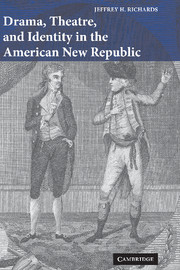Book contents
- Frontmatter
- Contents
- Acknowledgements
- Introduction
- 1 American identities and the transatlantic stage
- PART I Staging revolution at the margins of celebration
- PART II Coloring identities: race, religion, and the exotic
- PART III Theatre, culture, and reflected identity
- 11 Tales of the Philadelphia Theatre: Ormond, national performance, and supranational identity
- 12 A British or an American tar? Play, player, and spectator in Norfolk, 1797–1800
- 13 After The Contrast: Tyler, civic virtue, and the Boston stage
- Notes
- Bibliography
- Index
12 - A British or an American tar? Play, player, and spectator in Norfolk, 1797–1800
Published online by Cambridge University Press: 22 September 2009
- Frontmatter
- Contents
- Acknowledgements
- Introduction
- 1 American identities and the transatlantic stage
- PART I Staging revolution at the margins of celebration
- PART II Coloring identities: race, religion, and the exotic
- PART III Theatre, culture, and reflected identity
- 11 Tales of the Philadelphia Theatre: Ormond, national performance, and supranational identity
- 12 A British or an American tar? Play, player, and spectator in Norfolk, 1797–1800
- 13 After The Contrast: Tyler, civic virtue, and the Boston stage
- Notes
- Bibliography
- Index
Summary
The skepticism of a brockden brown about theatre's ability to render identity or the darkened mirror of racial, gender, ethnic, and class representations as contained in some of the plays discussed above could hardly stop the development and spread of theatre beyond the major sites of New York, Boston, Philadelphia, and Charleston. By 1790 the seaport town of Norfolk, Virginia, at the confluence of the James and Elizabeth Rivers and the entrance to the Chesapeake Bay, had risen from the ashes of the Revolution to become a bustling, growing, cosmopolitan city. Having been largely burned on January 1, 1776, by the departing royal governor of Virginia, Lord Dunmore, Norfolk had reconstructed its waterfront and downtown sufficiently to attract two traveling, professional theatre companies in 1790, that run by the Kennas and the new one formed by Thomas Wade West and his son-in-law partner, John Bignall. In the following year, Norfolk became a regular stop for West and Bignall on a circuit of Southern cities that included, in its heyday, Charleston, South Carolina, and five cities in Virginia: Richmond, Petersburg, Alexandria, Fredericksburg, and Norfolk. In 1792, West arranged the purchase of an L-shaped piece of property facing Fenchurch Street in Norfolk and over the next year constructed a new theatre building, relatively small in comparison to theatres built by West elsewhere, but made of brick and thought in its time to have fine appointments.
- Type
- Chapter
- Information
- Drama, Theatre, and Identity in the American New Republic , pp. 259 - 295Publisher: Cambridge University PressPrint publication year: 2005



